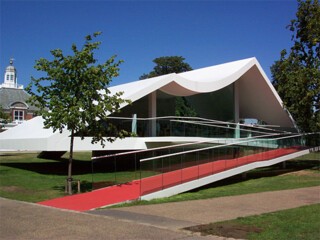Niemeyer’s Pavilion
Gillian Darley
Ever since I read about Oscar Niemeyer’s death last week I’ve been wondering where his only British building has gone. In 2003, at the age of 96, he was given the commission to design the Serpentine Pavilion. The pavilions built each summer in front of the Serpentine Gallery in Hyde Park are strictly temporary and it is said that the sale of each helps finance the next one. The invitees are all world-class architects who have not yet built in this country.
Niemeyer’s contribution is still my favourite. With its asymmetrical M of a frontage, like two eyebrows working to different agendas, it was a typically jaunty response to the light-hearted (if sometimes fraught) commission. Visitors zigzagged up to it along a lengthy ramp, a mood enhancer in itself. Such wandering approaches had become a hallmark of Niemeyer’s work.
It was everything that a pavilion in a park should be; Niemeyer intended it to be ‘free and audacious’. And, planning wrangles aside, so it was. Stellar architects rarely do levity but Niemeyer did. His energy was unquenchable and he designed with wit. Anyone with a similar spirit and a very deep pocket would welcome the pavilion at the bottom of their (extremely large) garden. Or is it packed away in a warehouse somewhere?
To my regret I’ve never visited Brasília, but from all accounts the city, planned by Lúcio Costa and designed by Niemeyer, is infused by this brio, writ large. Set it alongside Chandigarh, le Corbusier’s sweating, beached Indian metropolis, and there seems little to compare between the two – though both have the civic blankness of the instantaneous city. Niemeyer had admired and worked with le Corbusier for a while, before stealing something of a march on him.
The University of Haifa was designed according to Niemeyer’s master plan but has just one major building from his hand, the Eshkol Tower. It sits like a great blocky lighthouse on the brow of Mount Carmel, the only high-rise building I’ve even seen on top of a mountain. Yet, just as the turf of Hyde Park set off the airy pavilion in 2003, the university tower thrusts up from its plateau to dramatic effect. It brooks no interruption and recent additions to the campus seem to keep well away from his masterstroke.
The third Niemeyer building I’ve known is the Communist Party headquarters in the 19th arrondissement. Niemeyer, a lifelong communist, exiled from Brazil after the 1964 coup, moved to Paris in 1966. The sinuous, glass-fronted block on place du Colonel-Fabien was a bold insert into the mongrel, mostly 19th-century urban fabric – rundown Belleville coexisting with a little hilltop garden suburb and the strangest park in Paris, the entirely manmade Buttes-Chaumont. Paris waited many years for Niemeyer. But not as long as London had to.

Comments